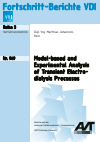Model-based and Experimental Analysis of Transient Electrodialysis Processes
Zusammenfassung
This thesis is concerned with the integration of a model-based and experimental analysis for the systematic investigation of transient electrodialysis (ED) processes. In this context a mechanistic process model for transient ED systems is developed which is based on a rigorous dynamic description of the underlying ionic transport processes. Important requirements for a systematic model development are elaborated in a systematic manner. This includes the development of a new method for the characterization of partial differential-algebraic equations and an experimental sensitivity analysis of a transient electrodialysis system. The findings can easily be generalized to related electrochemical processes such as fuel cells or batteries. By this means this work provides important results for scientist and engineers in the fields of mechanistic modeling, electromembrane processes and electrochemical systems.
...
Schlagworte
- Kapitel Ausklappen | EinklappenSeiten
- I–3
- 4–16 1 Introduction 4–16
- 1.1 Fundamentals of electrodialysis processes
- 1.1.1 Ion exchange membranes
- 1.1.2 Spacer-filled flow channels
- 1.1.3 Secondary transport effects
- 1.2 Ionic mass transport and process performance
- 1.2.1 Module and spacer design
- 1.2.2 Transient electrodialysis processes
- 1.3 Modeling ionic mass transport and electrodialysis processes
- 1.3.1 Investigation of spacers by CFD methods
- 1.3.2 Modeling of ion exchange membranes
- 1.3.3 Electrodialysis process modeling
- 1.3.4 Modeling ionic mass-transport in a homogenous phase
- 1.4 Conclusions and scope of this work
- 17–41 2 Experimental analysis of electrodialysis process dynamics 17–41
- 2.1 Experimental set-up and methods
- 2.1.1 Experimental set-up
- 2.1.2 Batch desalination experiments
- 2.1.3 Current-voltage experiments
- 2.1.4 Degrees of freedom, measurements and performance measures
- 2.2 Scope of the experimental study
- 2.3 Current-voltage behavior
- 2.4 Sensitivities with respect to operational and design parameters
- 2.4.1 Applied current
- 2.4.2 Volumetric flow rate
- 2.4.3 Comparison of different spacers
- 2.4.4 Discussion
- 2.5 Operation with transient applied currents
- 2.6 ED with pulsed current
- 2.6.1 Desalination of NaCl solution using a pulsed applied current
- 2.6.2 Desalination of NaCl - Na2SO4 solution using a pulsed applied current
- 2.6.3 Discussion
- 2.7 Conclusions
- 42–65 3 Index analysis and reduction of PDAE systems 42–65
- 3.1 Introduction
- 3.2 Index concepts for DAE and PDAE systems
- 3.2.1 Index concepts for DAE systems
- 3.2.2 Index concepts for PDAE systems
- 3.2.3 Comparison of the index concepts for PDAE systems
- 3.3 Index analysis and reduction for semi-explicit PDAE systems
- 3.3.1 Differential index
- 3.3.2 Index analysis
- 3.3.3 Generalization of the index reduction algorithm
- 3.3.4 Systematic procedure for the index analysis and reduction
- 3.4 Index analysis and reduction in the modeling work flow
- 3.4.1 Physical interpretation of the reformulated model
- 3.4.2 Identification of consistent initial and boundary conditions
- 3.5 Conclusions
- 66–83 4 Modeling of ionic transport in electrolytes 66–83
- 4.1 Modeling equations and theoretical framework
- 4.1.1 Species balance equations and definition of the reference velocity
- 4.1.2 Constitutive equations
- 4.1.3 Momentum balance equation and hydrodynamics
- 4.1.4 Complete mathematical models
- 4.2 Index analysis and reduction
- 4.2.1 Index with respect to time
- 4.2.2 Index with respect to the spatial coordinates
- 4.2.3 Reformulated low index model
- 4.3 Reduced system and consistent initial and boundary conditions
- 4.3.1 Reformulation into a reduced system of PDE
- 4.3.2 Initial and boundary conditions
- 4.4 Conclusions
- 84–110 5 A dynamic process model of an electrodialysis plant 84–110
- 5.1 Hierarchical model structure and model components
- 5.1.1 General modeling assumptions
- 5.1.2 Spacer-filled flow channels and ion exchange membranes
- 5.1.3 Electrodes and plant periphery
- 5.1.4 Interface models and coupling of model components
- 5.2 Problem specification and implementation
- 5.2.1 Degrees of freedom and model parameters
- 5.2.2 Implementation
- 5.3 Model-based analysis of dynamic transport effects
- 5.3.1 Dynamics in pulsed-current electrodialysis
- 5.3.2 Discrimination of transport resistances
- 5.3.3 Competitive transport in pulsed current experiments
- 5.3.4 Discussion
- 5.4 Comparison with experimental data
- 5.4.1 Current-voltage experiments
- 5.4.2 Batch desalination experiments
- 5.5 Conclusions
- 111–133 6 Spacer geometry and process performance 111–133
- 6.1 Towards an integrated description of hydrodynamics and ionic mass transport
- 6.2 Methods
- 6.2.1 Pressure drop experiments
- 6.2.2 Geometric modeling of the spacer and simulation scenario
- 6.2.3 Software and implementation
- 6.2.4 Semi-empirical modeling of pressure drop in spacer-filled channels
- 6.2.5 Work flow for model identification
- 6.2.6 Parameter estimation, identifiability analysis and design of experiments
- 6.3 Simulation results and validation
- 6.3.1 Velocity profiles
- 6.3.2 Pressure drop profiles
- 6.3.3 Comparison with experimental data
- 6.4 Identification of friction-factor models for varying design parameters
- 6.4.1 Non-woven spacers
- 6.4.2 Woven spacer
- 6.4.3 Predictive capabilities of the identified pressure drop models
- 6.5 Summary and Discussion
- 134–138 7 Concluding remarks 134–138
- 7.1 Summary
- 7.2 Outlook
- 139–160 Appendices 139–160
- A Geometrical properties and reproducibility of the experiments
- A.1 Geometric properties of the lab-scale ED plant
- A.2 Repeatability and measurement error
- A.2.1 Pulsed current
- A.2.2 Mixture experiments
- A.2.3 Current-voltage experiments
- A.3 Overview current-voltage experiments
- A.4 Desalination experiments
- B Physico-chemical property models for electrolytes
- B.1 Conversion of different reference velocities
- B.2 Conversion of activity coefficients
- B.3 Multi-component density model
- B.4 Maxwell-Stefan diffusion coefficients for aqueous electrolyte solutions
- B.4.1 MS coefficients of ion-ion pairs
- B.4.2 MS coefficients of ion-water pairs
- B.5 Model parameters
- C Results of pressure drop model identification
- C.1 Geometric parameters of the spacer geometries in the basis data set
- C.2 Parameter estimates for the final friction coefficient model for the non-woven and woven spacer
- C.3 Model candidates for the identification of a generalized pressure drop model
- 161–177 Bibliography 161–177


